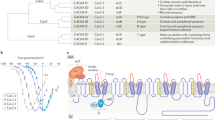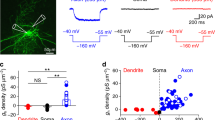Abstract
STIMULATION of the motor nerve, in addition to producing the synchronous, impulsive release of acetylcholine (ACh) that is recorded electrophysiologically as the endplate potential (e.p.p.)1, also elicits a delayed, asynchronous discharge of ACh quanta that appears as increases in miniature endplate potential (m.e.p.p.) frequencies2–4. The synchronous release of ACh is mediated by the movement of Ca2+ through specific conductance channels activated by depolarisation of the motor nerve ending (for reviews see refs 1, 5 and 6). Although asynchronous release is dependent in some fashion on extracellular (Ca2+) (ref. 4) there seems to be a controversy as to the precise nature of the ionic pathway responsible for this dependence. For example, although it has been suggested that asynchronous evoked release is mediated by residual Ca2+ that enters through the traditional Ca2+ conductance pathway3, results with Mg2+ have suggested the contrary4. Specifically, it has been shown that Mg2+, rather than antagonising the asynchronous release of ACh in Ca2+ solutions, (as would be expected if Ca2+ moved through the same conductance pathway for both forms of release7–10), actually enhanced the asynchronous discharge of ACh quanta4. The present study investigated the effects of the conventional Ca2+ antagonists, Co2+ and Mg2+, on the asynchronous evoked release of ACh. The results demonstrate that after brief, repetitive stimulation, both ions competitively antagonise asynchronous ACh release in a manner similar to their respective antagonism of synchronous release7,10. We conclude that Ca2+ supports both dispersed and synchronous ACh release through the same conductance pathway.
This is a preview of subscription content, access via your institution
Access options
Subscribe to this journal
Receive 51 print issues and online access
$199.00 per year
only $3.90 per issue
Buy this article
- Purchase on Springer Link
- Instant access to full article PDF
Prices may be subject to local taxes which are calculated during checkout
Similar content being viewed by others
References
Katz, B. Release of Neural Transmitter Substances (University Press, Liverpool, 1969).
del Castillo, J. & Katz, B. J. Physiol., Lond. 124, 574–585 (1954).
Miledi, R. & Thies, R. J. Physiol., Lond. 212, 245–257 (1971).
Hurlbut, W. P., Longnecker, H. B. & Mauro, A. J. Physiol., Lond. 219, 17–38 (1971).
Hubbard, J. I. Physiol. Rev. 53, 674–723 (1973).
Ginsborg, B. L. & Jenkinson, D. H. in Neuromuscular Junction, Handbook of Experimental Pharmacology (ed. Zaimis, E.) 229–364 (Springer Verlag, New York, 1976).
del Castillo, J. & Katz, B. J. Physiol., Lond. 124, 560–573 (1954).
Jenkinson, D. H. J. Physiol., Lond. 138, 434–445 (1957).
Dodge, F. A., Jr & Rahamimoff, R. J. Physiol., Lond. 193, 419–432 (1967).
Crawford, A. C. J. Physiol., Lond. 240, 255–278 (1974).
Eisenberg, R. S., Howell, J. N. & Vaughan, P. C. J. Physiol., Lond. 215, 95–102 (1971).
Katz, B. & Miledi, R. Proc. R. Soc. Lond. B 192, 27–38 (1975).
Gaddum, J. H. Pharmac. rev. 9, 211–218 (1957).
Weakly, J. N. J. Physiol., Lond. 234, 597–612 (1973).
Baker, P. F. Progr. Biophys. molec. Biol. 24, 177–223 (1972).
Silinsky, E. M. Br. J. Pharmac. 59, 215–217 (1977).
Dodge, F. A., Jr., Miledi, R. & Rahamimoff, R. J. Physiol., Lond. 200, 267–283 (1969).
Silinsky, E. M. J. Physiol., Lond. (in the press).
Author information
Authors and Affiliations
Rights and permissions
About this article
Cite this article
SILINSKY, E., MELLOW, A. & PHILLIPS, T. Conventional calcium channel mediates asynchronous acetylcholine release by motor nerve impulses. Nature 270, 528–530 (1977). https://doi.org/10.1038/270528a0
Received:
Accepted:
Issue Date:
DOI: https://doi.org/10.1038/270528a0
Comments
By submitting a comment you agree to abide by our Terms and Community Guidelines. If you find something abusive or that does not comply with our terms or guidelines please flag it as inappropriate.



